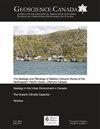The Great Preglacial “Bell River” of North America: Detrital Zircon Evidence for Oligocene–Miocene Fluvial Connections Between the Colorado Plateau and Labrador Sea
IF 1.8
4区 地球科学
Q3 GEOSCIENCES, MULTIDISCIPLINARY
引用次数: 1
Abstract
The idea of a great pre-glacial river that drained much of North America into the Arctic waters of modern Canada was first suggested in 1895 by Robert A. Bell. In the 1970s, petroleum exploration in Hudson Strait and the Labrador Sea located the massive, submerged delta of what is now known as the Bell River. Reconstructions suggest that three main branches of the Bell River joined up near modern Hudson Bay. The eastern branch largely drained the Canadian Shield, but the central and western branches had headwaters in the Cordilleran orogenic belt and its foreland in the present-day U.S. and northwestern Canada, respectively. We present new detrital zircon U–Pb data from Lower Oligocene and Lower Miocene sand from an exploration well in the Saglek delta of the northern Labrador Sea. In conjunction with other detrital zircon results from the Labrador Sea (and elsewhere) these data record the configuration and history of this continental-scale drainage basin in more detail. Mesozoic and younger detrital zircon grains (< 250 Ma) are subordinate to Precambrian age groupings, but Cenozoic populations become more abundant during the Oligocene, suggesting that the basin had expanded into areas now occupied by the Colorado Plateau and the Basin-and-Range Province. Proterozoic and Phanerozoic detrital zircon grain populations in Saglek delta sediments are similar to those of the Pliocene Colorado River. The results support an earlier idea that initial incision of the Grand Canyon and denudation of the Colorado Plateau were associated with a north-flowing paleo-river that fed into the Bell River basin. This contribution continued until the Pliocene capture of this ancestral river by the Gulf of California basin, after which the excavation of the modern Grand Canyon was completed. The Bell River drainage basin was later blocked by the expansion of Pleistocene ice sheets.北美大冰期前“贝尔河”:科罗拉多高原与拉布拉多海之间渐新世-中新世河流连接的碎屑锆石证据
1895年,罗伯特·a·贝尔首次提出了一条冰川前大河的想法,这条大河将北美大部分地区排入现代加拿大的北极水域。20世纪70年代,哈德逊海峡和拉布拉多海的石油勘探发现了现在被称为贝尔河的巨大的淹没三角洲。重建表明,贝尔河的三条主要支流在现代哈德逊湾附近汇合。东部分支在很大程度上排干了加拿大地盾,但中部和西部分支的源头分别位于科迪勒兰造山带及其在当今美国和加拿大西北部的前陆。我们提供了来自拉布拉多海北部Saglek三角洲一口探井的下渐新世和下中新世砂的新碎屑锆石U–Pb数据。结合拉布拉多海(和其他地方)的其他碎屑锆石结果,这些数据更详细地记录了该大陆规模流域的构造和历史。中生代和较年轻的碎屑锆石颗粒(<250Ma)属于前寒武纪年龄组,但新生代种群在渐新世变得更加丰富,这表明该盆地已扩展到现在被科罗拉多高原和盆地与山脉省占据的地区。Saglek三角洲沉积物中的元古代和显生宙碎屑锆石颗粒群与上新世科罗拉多河的颗粒群相似。研究结果支持了早期的观点,即大峡谷的初始切口和科罗拉多高原的剥蚀与流入贝尔河流域的一条向北流动的古河流有关。这种贡献一直持续到上新世加利福尼亚湾盆地对这条祖先河流的占领,之后现代大峡谷的挖掘完成。贝尔河流域后来被更新世冰盖的扩张所阻断。
本文章由计算机程序翻译,如有差异,请以英文原文为准。
求助全文
约1分钟内获得全文
求助全文
来源期刊

Geoscience Canada
地学-地球科学综合
CiteScore
3.30
自引率
0.00%
发文量
9
审稿时长
>12 weeks
期刊介绍:
Established in 1974, Geoscience Canada is the main technical publication of the Geological Association of Canada (GAC). We are a quarterly journal that emphasizes diversity of material, and also the presentation of informative technical articles that can be understood not only by specialist research workers, but by non-specialists in other branches of the Earth Sciences. We aim to be a journal that you want to read, and which will leave you better informed, rather than more confused.
 求助内容:
求助内容: 应助结果提醒方式:
应助结果提醒方式:


